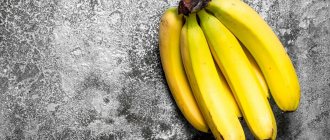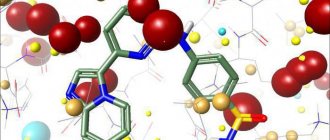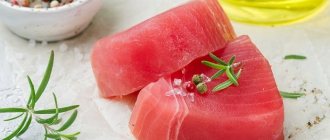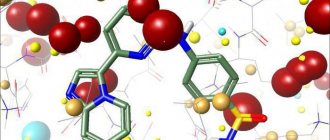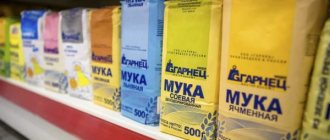What are carbohydrates?
Carbohydrates are organic substances that are the main source of energy for your body. It is one of the three macronutrients you need to survive. The other two are proteins and fats .
Types of carbohydrates:
- Monosaccharides are the simplest carbohydrates that do not break down into even simpler ones. For example, glucose, fructose.
- Oligosaccharides are more complex compounds, built from several (up to 10) monosaccharide residues. For example, beet raffinose.
- Disaccharides are complex compounds built from 2 monosaccharide residues. For example, beet or cane sugar, lactose (milk sugar).
- Polysaccharides are complex compounds formed from a large number of glucose residues. They are divided into digestible (starch) and non-digestible (fiber). Fiber, due to its properties, has a beneficial effect on the entire body as a whole. Helps prevent many diseases, including cancer.
Types of carbohydrates
Let's look at what carbohydrates are, what groups they are divided into and how they are classified.
Simple:
Monosaccharides : These include Glucose (also known as dextrose), Fructose (also known as levulose, or fruit sugar), and Galactose.
Disaccharides : which include Sucrose, Lactose and Maltose.
Simple carbohydrates or sugars can cause a sharp rise in blood sugar levels, thereby stimulating excess insulin production, which in turn causes a sharp drop in blood sugar. Glucose and maltose have the highest glycemic indices (see below).
Difficult:
Oligosaccharides : (partially digestible polysaccharides) include Maltodextrins, Fructooligosaccharides, Raffinose, Stachyose and Verbascose. These partially digestible polysaccharides are mainly found in legumes and, although they can cause gas and bloating, they are considered healthy carbohydrates. They are less sweet than mono- or disaccharides. Raffinose, stachyose, and fructooligosaccharides are found in small quantities in certain legumes, grains, and vegetables.
Polysaccharides : (easily digestible and indigestible polysaccharides). Easily digestible polysaccharides include Amylose, Amylopectin and Glucose Polymers. These complex carbohydrates should be the main source of carbohydrate energy. Glucose polymers are derived from starch and are often used in sports drinks and energy gels for athletes.
Indigestible polysaccharides : These complex carbohydrates provide the body with the dietary fiber needed for healthy gastrointestinal function and disease resistance.
Other complex carbohydrates : include Mannitol, Sorbitol, Xylitol, Glycogen, Ribose. Mannitol, sorbitol and xylitol (sugar alcohols) are non-caries nutritional sweeteners whose moisture-retaining and stabilizing properties are often used in food products; however, they are slowly digested and, when consumed in large quantities, cause gastrointestinal distress. The main form of carbohydrate storage in the body of animals is glycogen; Ribose, in turn, is part of the genetic code.
Functions of carbohydrates in the human body
- The role of carbohydrates is great. Once in the gastrointestinal tract, they are broken down into glucose, which in turn enters the cells and is used by the body as a source of energy. When they are insufficient to produce energy, proteins and fats break down, which leads to the accumulation of toxic ketones in the blood.
- They are able to accumulate in the liver, skeletal muscles, and other tissues in the form of glycogen.
- They take part in the synthesis of many substances necessary for the normal functioning of your body. For example, complex proteins, components of the immune system, etc.
- Regulates the metabolism of proteins and fats.
- Necessary for the normal functioning of the heart, liver, muscles and central nervous system.
Carbohydrates
Carbohydrates (or sugars) are the name for a broad class of organic compounds consisting of “coal” and “water.” Scientifically, these are polyalcohols with one carbonyl group. They enter the body with food, are broken down into glucose and accumulate in the liver and muscles. These reserves are called glycogen. They account for approximately 3% of body weight, and they perform a wide variety of vital functions:
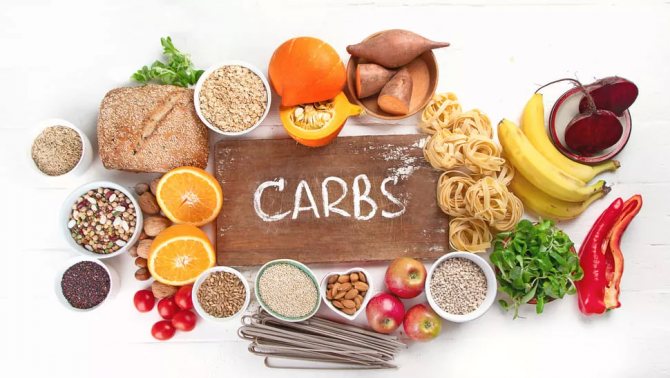
- Energy sources. Energy replenishment of the brain and muscles.
- Helps in blood clotting, regulates intestinal peristalsis and osmotic processes.
- Take part in the structure of various shells. Sugars are the main component in the cell walls of bacteria, plants and fungi. Invertebrates have a chitinous shell. Fiber, also a member of the carbohydrate class, can be found in plant tissues. It is actively used by intestinal microflora and regulates food processing.
— As part of nucleic acids, ribose and deoxyribose take an active part in plastic metabolism, synthesize new hormones, membranes, and enzymes.
“These compounds underlie the selective action of immunity on pathogenic, pathogenic microbes, and therefore protect a person from unwanted invasions.

Classification and types of carbohydrates
Depending on the composition, structure, and properties, sugars have several classifications. They are divided into three groups: monosaccharides or monosaccharides (glucose, fructose), disaccharides (sucrose, maltose) and polysaccharides or polyoses (cellulose, starch, pectic acids). Monosaccharides are divided according to the number of carbon atoms into trioses, tetroses, heptoses, pentoses, etc. They are also classified by digestibility, which is more popular in sports.
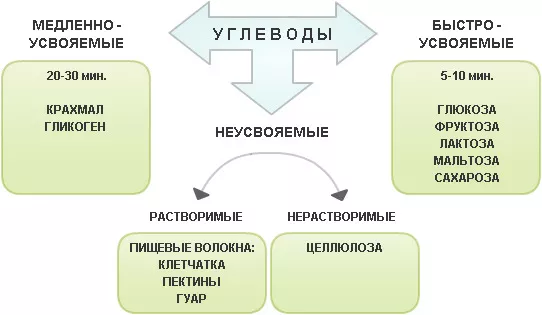
Instantly digestible or fast carbohydrates are those sugars that can produce energy within 20 minutes. They are recommended to be taken as part of gainers by people with an asthenic physique half an hour before heavy exercise. This group includes glucose, fructose, galactose, sucrose, lactose, manose, maltose.
Slowly digestible or slow carbohydrates. First of all, these are polysaccharides, which take a long time to break down into monomers and can provide a person with energy in about 40 minutes. The rate of breakdown (assimilation) depends on the structure. Monoses consist of one molecule. Polioses consist of several components, monomers, and the body must first break them down into individual components, and then process them into a “source of vigor.”
There are also indigestible carbohydrates. This does not mean that they need to be excluded from the diet. Fiber (it is mainly indigestible carbohydrates) serves as a food source for intestinal microflora. With a lack of fiber, diseases of the gastrointestinal tract develop.
Food sources of carbohydrates
Carbohydrates should dominate the menu of an athlete who cares about his health. For athletes, they should make up at least half of all nutrients.
They are formed during the process of photosynthesis, so the basis of the diet is mainly plants: vegetables, fruits and sometimes berries. Fast sugars are found in natural honey, sugar, baked goods, white rice and semolina flour, light wheat pasta, dried fruits, sweet fruits, and some vegetables. Slow carbohydrates are found in mushrooms, herbs, all types of vegetables, durum wheat pasta, cereals, and legumes.
Therefore, most of the above products should be included in the menu of people who are interested in any active activity. They are especially important for those who need endurance and weightlifters. This set: carbohydrates, fats, proteins is fundamental, it is rich in substances that stimulate the nervous system and muscles for long-term physical activity and ensure the building of muscle mass. Glycogen is the main, if not the main source of nutrition for working muscles. With a lack of carbohydrates, your body begins to use emergency reserves, which can cause muscles to work at their own expense (the goal of gaining muscle mass will not be achieved).
Carbohydrates and sports
Pure carbohydrates are rare in sports nutrition, as they are found in almost every food product. But they are often included in diet lists for gaining muscle mass or losing weight. The calculation of sugar consumption is made individually, taking into account the amount of training a person does, his body weight, and lifestyle. Basically, they look at the glycemic index. Products with a low glycemic index are polysaccharides; they give their energy to the body for a long time. They cope well with suppressing the need for food and prolonged exercise. High GI foods are fast-absorbing sugars and are often taken after exercise to replenish glucose in connective tissue.

Amylopectin is similar to starch and is quickly absorbed. Bodybuilders use it to maintain muscle tone, rapid regeneration, and improve protein synthesis. To increase muscle mass, amylopectin is an ideal substance. It is in demand in sports with long-term physical activity. The diet is calculated for everyone individually, but on average, athletes consume 0.5-1 g of amylopectin per 1 minute of intense exercise. The glycemic index of amylopectin is 85.
Dextrose is an optical isomer of glucose. The carbohydrate is classified as “very quickly digestible” and is partially absorbed in the oral cavity. Provides recovery after workouts. Dextrose allows athletes to keep their blood sugar levels high, delaying muscle exhaustion. Application also helps to increase strength capabilities. Use dextrose - 0.5-1 g per 1 minute of intense exercise. The glycemic index of dextrose is 100.
Maltodextrin is a substance obtained from the processing of starch, which is not a sugar. It is often included in dietary supplements, gainers and isotonics. It is popular in sports because of its rapid absorption and ability to keep the body on easily digestible fuel. The glycemic index of maltodextrin is approximately 130. The only drawback of the supplement is that it is very high in calories, although it contains no fat at all. It can be distinguished from dextrose by its softer and more pleasant taste.
Inulin is a plant analogue of glycogen that is not absorbed by the body. It stimulates weight loss by accelerating lipid metabolism and reducing protein absorption; it also suppresses hunger, normalizes food digestion and speeds up metabolism. The glycemic index of inulin is 14.
Rules and reception times
At night, a person does not receive carbohydrates, so the processing of reserves (glycogen) is activated. In the morning and for several hours after getting up, the body consumes energy stored earlier (as well as at night). In the afternoon, on the contrary, the bulk of carbohydrates goes to replenishing reserves. That is why the right solution is to gradually reduce the carbohydrate content in food throughout the day. Many athletes use this cheat sheet to achieve maximum results. Here she is:
The first 6 hours after waking up: 30% proteins, 30% fats, 40% carbohydrates with an average GI; From 6 to 12 hours after waking up: 40% proteins, 30% fats, 30% low GI carbohydrates; From 12 to 17 hours after waking up: 50% protein, 30% fat, 20% low GI carbohydrates.
Accordingly, the maximum amount of carbohydrate-containing foods should be consumed in the morning. For proper functioning of the body throughout the day, the diet should increase the content of food with a low glycemic coefficient. But after exercise and exercise, you definitely need to saturate your muscles with high-glycemic sugars. This will help them recover and tone up. If you doubt that the amount of carbohydrates you receive is enough for your body, you can calculate your daily requirement using the formula: take 7 g of carbohydrates per kilogram of your own weight. It is suitable if your goal is to gain muscle mass.
More often, athletes take carbohydrates in the form of bars or supplements (gainers and isotonics). There are also special carbohydrate diets for each sport and activity. Before you start using any product or following a diet, be sure to consult a specialist.
Side effects of use
If you eat too many fast carbohydrates, fat mass may form instead of muscle mass, since only a certain amount of glycogen can be stored in the muscles. Do not abuse sugar, do not neglect the opinion of experts.
What foods contain carbohydrates
Most foods are carbohydrates. They are not found in products of animal origin (meat, fish and seafood, eggs, etc.). The exception is dairy products that contain the milk sugar lactose.
Sources:
- Fruits.
- Vegetables, greens.
- Cereals, different types of flour.
- Nuts and seeds.
- Legumes (beans, peas, lentils, soybeans).
- Bread, pastries, cakes, pastries, etc.
- Pasta, noodles.
- Sugar, starch, honey.
- Carbonated drinks with sugar, compote, juices, tea and coffee with sugar.
- Alcohol.
- Dairy products, etc.
Kinds
Carbohydrates are a large group of organic substances. They are classified according to two criteria:
- number of carbon atoms;
- number of structural units.
Depending on the number of carbon atoms in one molecule (structural unit), the following are distinguished:
- trioses;
- tetroses;
- pentoses;
- hexoses;
- heptoses.
The molecule can contain up to nine carbon atoms. The most significant are pentoses (C5H10O5) and hexoses (C6H12O6). Pentoses are components of nucleic acids. Hexoses are part of polysaccharides.
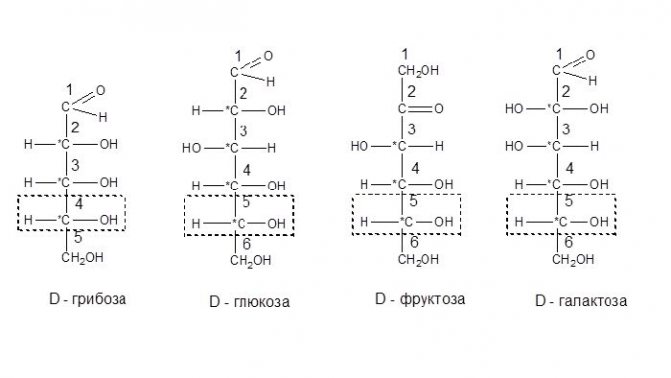
Rice. 1. Monosaccharide structure.
According to the second classification criterion, carbohydrates are:
- simple , consisting of one molecule or structural unit (monosaccharides);
- complex , including many molecules (oligosaccharides, polysaccharides).
Features of complex structures are described in the table of carbohydrates.
| Kinds | Formula | Characteristic | Examples |
| Monosaccharides | Cn(H2O)n | Consist of one structural unit. Contains DNA, RNA, and ATP. Depending on the open group, ketoses (R1-CO-R2) and aldoses (R-CHO) are distinguished | Glucose, fructose, ribose |
| Oligosaccharides | CmH2nOn | Consist of 2-10 monosaccharides. May contain the same monosaccharide residues (homooligosaccharides) or different ones (heterooligosaccharides) | Sucrose, lactose, maltose |
| Polysaccharides | CnH2mOm | Consist of many monosaccharides (from 10 to several thousand) | Cellulose, chitin, starch |
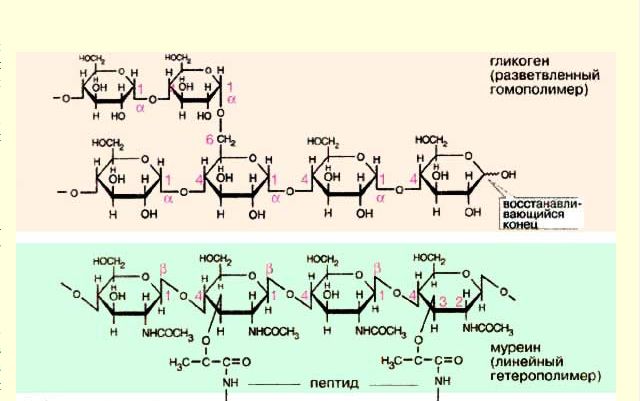
Rice. 2. Polysaccharide structure.
One of the most significant types of oligosaccharides is disaccharides, consisting of two monosaccharides. They serve as a source of glucose and perform a construction function in plants.
Grocery list
Simple carbohydrates
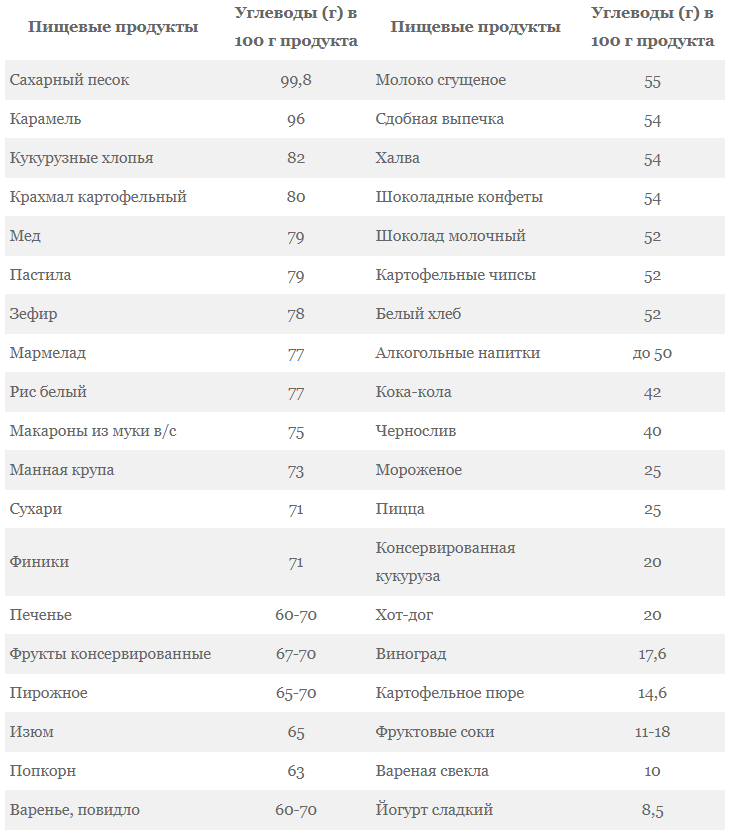
Complex carbohydrates
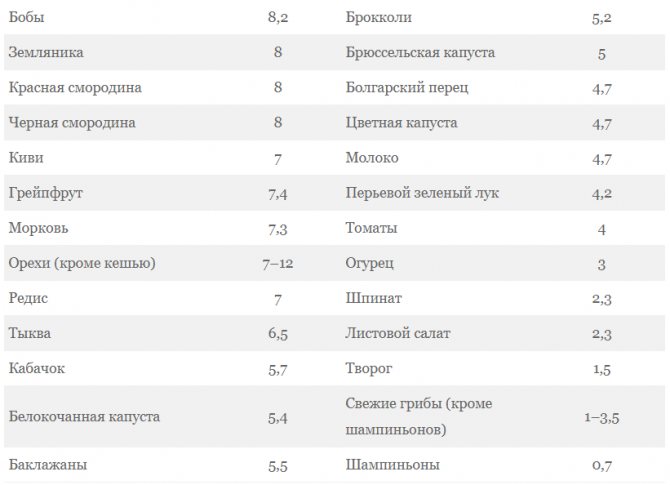
Structure
A carbohydrate molecule consists of several carbonyl (=C=O) and hydroxyl (-OH) groups. Depending on their structure, there are three groups of carbohydrates:
- monosaccharides;
- oligosaccharides;
- polysaccharides.
Monosaccharides are the simplest sugars, consisting of just one molecule. Monosaccharides include several groups that differ in the number of carbon atoms in the molecule - structural unit. Monosaccharides containing three carbon atoms are called trioses, five are pentoses, six are hexoses, and so on. The most significant for living organisms are pentoses, which are part of nucleic acids, and hexoses, which make up polysaccharides. An example of a hexose is glucose.
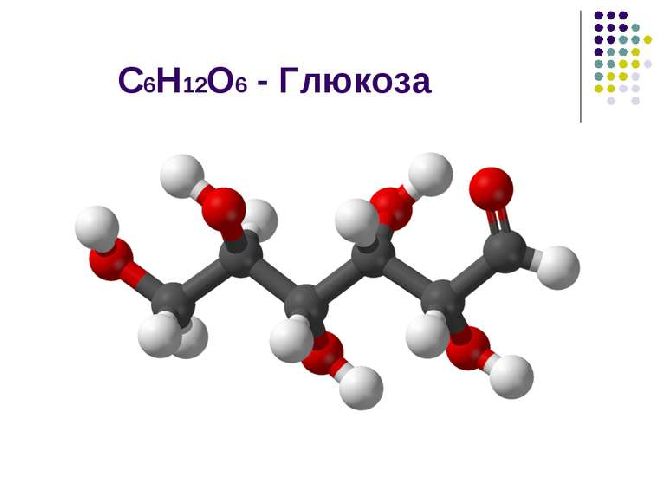
Rice. 1. Glucose.
Oligosaccharides include from two to 10 structural units. Depending on their quantity, they are distinguished:
- disaccharides – dioses;
- trisaccharides – trioses;
- tetrasaccharides – tetraoses;
- pentasaccharides;
- hexasaccharides, etc.
The most significant are disaccharides (lactose, sucrose, maltose) and trisaccharides (raffinose, melicitose, maltotriose).
The composition of oligosaccharides can include homogeneous and heterogeneous molecules. In this regard, they distinguish:
- homooligosaccharides - all molecules of the same structure;
- heterooligosaccharides are molecules of different structures.
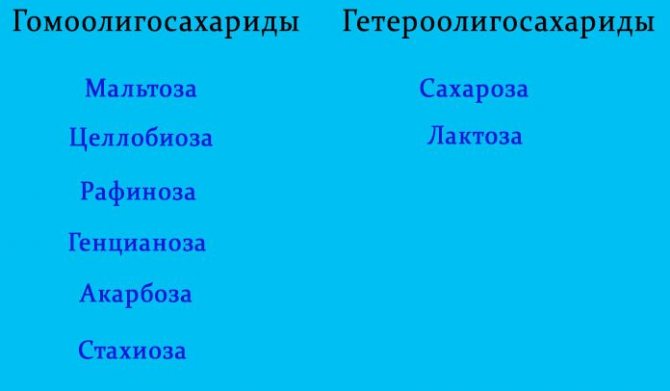
Rice. 2. Homooligosaccharides and heterooligosaccharides.
The most complex carbohydrates are polysaccharides, consisting of many (from 10 to thousands) monosaccharides. These include:
- cellulose;
- glycogen;
- starch;
- chitin.

Rice. 3. Polysaccharide.
Unlike oligosaccharides and monosaccharides, polysaccharides are hard, water-insoluble substances without a sweet taste.
The formula of carbohydrates is Cn(H2O)m. Every carbohydrate molecule contains at least three carbon atoms.
Daily carbohydrate needs
The daily intake will be different for each person.
On the Internet, some sites claim that the carbohydrate norm is 3–5 g per 1 kg of weight. In reality, everything is more complicated. The norm must be calculated for each person individually .
The need depends on gender, age, weight, activity level , etc. Also, your current goals are of great importance. For example, when losing weight and gaining muscle mass, you need completely different amounts of carbohydrates per day.
As an example, calculations were made for a 30-year-old man and woman of average height and low activity. See table below.
In the case of weight gain, average activity was taken (3 workouts per week).
Based on your gender, weight, and weight goals, you can determine your carbohydrate needs. Of course, the figure is approximate, but the error will not be very large.
| 50 -55 kg | 55-60 kg | 60-65 kg | 65-70 kg | 75-80 kg | 80-85 kg | |
| Men | ||||||
| Weight loss | 140 | 145 | 150 | 155 | 160 | 165 |
| Weight maintenance | 160 | 165 | 170 | 175 | 180 | 185 |
| Muscle gain | 270 | 280 | 290 | 300 | 315 | 325 |
| Women | ||||||
| Weight loss | 110 | 115 | 120 | 125 | 135 | 140 |
| Weight maintenance | 130 | 137 | 145 | 150 | 160 | 165 |
| Muscle gain | 228 | 240 | 245 | 255 | 270 | 280 |
When gaining muscle mass, the body needs a lot of energy. In this case, it is recommended to focus on foods high in carbohydrates. Of course, not forgetting about proteins and fats.
Lack of carbohydrates
A deficiency can cause weakness, fatigue, irritability, and apathy. In addition, muscle tissue and fat reserves, as well as proteins and fats supplied with food, will begin to be used as a source of energy.
Excess carbohydrates
Excessive amounts of them lead to a set of extra pounds .
Abuse of simple carbohydrates can lead to diabetes, arterial hypertension, insulin resistance, cardiovascular diseases and cancer.
Complex carbohydrates , on the contrary, can prevent these and other diseases . Fiber plays a big role here.
When the need increases
Since carbohydrates are the main source of energy, the need for them increases with increased mental and physical activity. If you decide to play sports, gain muscle mass, or your new job involves heavy physical activity, increase the amount of carbohydrate-containing foods.
Carbohydrates and physical activity
Physical activity dramatically increases energy expenditure, and any athlete, regardless of type of training, must strategize how best to meet their energy needs in order to achieve success in their field.
It is critical for individuals who exercise to obtain sufficient energy to meet all of the body's needs, including tissue maintenance, tissue growth and repair, and the direct energy expenditure of physical activity. Almost all surveys conducted among athletes showed that they do not consume enough energy to meet their body's needs.
You can look at it this way: when planning a long car trip of 500 km, at a gas station you fill up with fuel that is only enough for 80 km of travel - the car simply will not reach its destination; Likewise, poorly fueled athletes will also experience difficulties and will not be able to be competitive enough. It is well known that athletes should consume enough carbohydrates to cover most of the energy expenditure during physical activity, and additionally eat the amount of carbohydrates necessary to restore glycogen stores between workouts.
Ideally, they should primarily eat complex carbohydrates and consume simple carbohydrates during and immediately after exercise. Other sources of energy (proteins and fats) must also be present in the diet in order to fully meet all the body's nutritional needs, but carbohydrates should still be the main energy resource. When playing sports, without a clearly thought-out approach to the diet, it is very difficult to get enough energy and carbohydrates. Don't forget that training goes hand in hand with proper nutrition planning.
Laboratory diagnostics of carbohydrate metabolism
Previously, before the advent of modern research methods, doctors were faced with a not particularly noble job: they had to taste urine - and in diabetics it was sweet. Now the task has become somewhat simpler - so, what laboratory indicators are worth paying attention to:
- Triglycerides > 1.7 mmol/l.
An increase in the level of insulin in the blood stimulates lipogenesis - this, by the way, plays an important role in the pathogenesis of acne development: the higher the level of triglycerides, the more sebum is secreted.
- Fasting insulin >5-6 mmol/l.
- NOMA index > 1.3.
- Fasting glucose >5.5 mmol/l.
Optimum: 3.5-5.5 mmol/l.
- Glucose on oral glucose tolerance test >11 mmol/L.
Optimum: <6.9 mmol/L (6.9-11 mmol/L indicates prediabetes).
- Glycated hemoglobin - reflects the average blood sugar content over 3-4 months (lifespan of red blood cells) > 6.5%.
Optimum: up to 5.2%.
- C-peptide is a molecule that is cleaved by protein enzymes from the precursor of insulin and is thus an indicator of its secretion.
Reference: 1.4-4.4 ng/l.
Optimum: middle of reference values.
- LDL (low-density lipoprotein, atherogenic) > 3 mmol/l.
- HDL (high density lipoprotein, antiatherogenic) < 1 mmol/l in men and < 1.2 mmol/l in women.
Glycemic index
(GI) is an indicator of exactly how the carbohydrates consumed affect changes in glucose levels.
As previously mentioned, a feature of simple sugars is their ability to sharply increase the glucose level in the serum - this effect does not distinguish them favorably from complex carbohydrates.
We recommend
“Complex carbohydrates for weight loss, muscle gain and diabetics” Read more
The body's reaction is immediate: a powerful release of insulin occurs in the pancreas - a hormone designed in this case to neutralize excess glucose in the blood, but then follows the same uneven sharp decline. Hence the need to focus on foods with a low glycemic index that do not cause such “swings” in glucose concentrations:
- Chickpeas
- Beans
- Plums
- Pomegranate
- Cherry
- Raspberries
- Currant
- Mushrooms
- Broccoli
- Asparagus
- Fennel
- Lentils
- Avocado
- Olives
- Seaweed
- Cauliflower
- cucumbers
- Leafy vegetables
However, another indicator is no less important - the insulin index.
. It displays the amount of insulin secreted in response to the intake of a specific food.
Very often, foods with a low glycemic index, while having a high insulin index, cause many adverse effects. Such foods include dairy products.

Amino acids with branched side chains contained in milk are powerful stimulators of the synthesis and subsequent release of insulin (the AI of cottage cheese is approximately 100-120). This is a paradoxical situation at first glance: cottage cheese does not cause a sharp jump in glucose (GI = 30 and is quite low), but it leads to a significant secretion of insulin, to the calls of which the cells are already deaf.
The pancreas compensatory begins to produce more and more insulin in order to somehow break through the insurmountable wall - this eventually leads to its depletion. The patient is forced to receive it from the outside - in the form of injections.
The harm of fructose and corn syrup
Since childhood, we have become accustomed to advertising, with firm confidence driving into the faceted slabs of memory that juices for breakfast or for children as a snack at school are an excellent and healthy alternative to sugar. It would seem that there is nothing wrong with a smoothie or fresh juice - after all, fruits have always been associated with health! To answer this question it is necessary to turn again to biochemistry.
Our cells are not able to use fructose as an energy source, so its metabolism in the liver includes only two ways: conversion into glucose or the formation of triglycerides (fat, in a word).
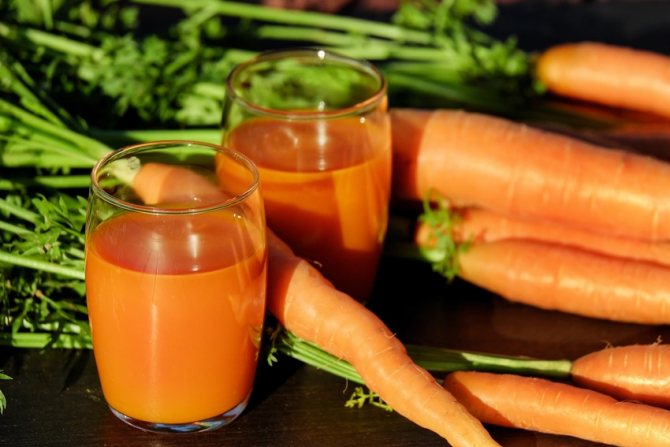
This monosaccharide plays a key role in the development of non-alcoholic fatty liver disease. Imagine foie gras: the unfortunate animal is force-fed so that its liver becomes overgrown with a sheath of fat, turning into a gourmet restaurant dish. The human one will be little different - except that no one will serve it to you on a white plate.
High daily consumption of this monosaccharide leads to the development of more severe liver damage: non-alcoholic steatohepatitis and cirrhosis.
Study
: Does fructose consumption contribute to non-alcoholic fatty liver disease?
This is why it is so important to pay attention to your waist size—its increase will be the first warning sign.
But the insidiousness of fructose doesn’t end there: it bypasses many satiety signals in our body. It's all about leptin, the satiety hormone that is secreted by adipose tissue. Its release is increased by the action of insulin, the concentration of which in the blood after consuming fructose will be quite low.
Moreover, fructose, unlike glucose, is not transported into the nervous tissue of the brain - and it does not pick up satiety signals. Thus, the feeling of hunger does not disappear even after eating - a person simply cannot get enough.
Study
: Consumption of high-fructose corn syrup in beverages may play a role in the epidemic of obesity
Excessive consumption of fructose is associated with increased levels of uric acid, a trigger in the development of gout.
Scientists conducted an interesting study with rats that followed a high-fructose diet for ten weeks. They experienced increased blood pressure and triglyceride levels, as well as the development of insulin resistance.
However, in the group that simultaneously took uric acid-lowering drugs (allopurinol and benzbromarone), these indicators were significantly better.
Study
: The Effect of High-Fructose Corn Syrup Consumption on Triglycerides and Uric Acid
A high-fructose diet promotes an overgrowth of gram-negative flora, and lipopolysaccharide, a component of their cell wall, enters the bloodstream. Watchdogs in the form of receptors immediately react to it - oxidative stress is triggered and the transmission of signals from insulin is simultaneously inhibited both in its peripherally located target cells and in the neurons of the hypothalamus - the most important structure of the brain.
It is important to add that such strong agents as free radicals, even if in this case they are formed outside the mitochondria, easily penetrate into the latter, causing transport collapse there in the form of electron leakage.
Study
: Consumption of high-fructose corn syrup in beverages may play a role in the epidemic of obesity
In the 1970s, it accounted for less than one percent of its sales in the American sweetener market. By the 2000s, its share had already reached 42% - an amazing success.
Today it is difficult to find a product in the United States in which manufacturers do not add it: soft drinks, candied fruits, yogurts, baked goods, jellies and even many cereals - it is lost on their labels. All this leads to an increase in the incidence of obesity among children and adolescents - the main consumers of sugary drinks, cereals and desserts.
The fructose content in this syrup varies from 42% to 55%
.
Studies have shown that consuming corn syrup increases glucose (and therefore insulin) levels.
It is recommended to consume about 100-150 grams
carbohydrates per day (provided there are no metabolic disorders).
So, after we eat any food containing carbohydrates and proteins (we will focus on them in other articles), the cells of the pancreas begin to actively secrete insulin.
This is a protein hormone whose main task is to reduce blood glucose levels. Insulin itself does not transport anything: by interacting with its receptors, it only increases the density of specific carriers on the cell surface.
Glucose enters the cell, where various pathways for its utilization are activated:
- Glycolysis
— this process supplies raw materials for power plants, in other words, prepares firewood for mitochondrial furnaces.
Glucose is converted into pyruvate (pyruvic acid), which, in turn, in the absence of oxygen is metabolized into lactic acid - lactate (it is these processes that occur in actively contracting muscles during physical activity).
In aerobic, that is, oxygen, conditions, pyruvate, in the process of biochemical reactions and with the participation of a complex of a large number of enzymes, is converted into acetyl-CoA, which enters the tricarboxylic acid cycle (Krebs cycle).
In fact, all incoming food (proteins, fats, carbohydrates) will ultimately form acetyl-Coa - this is a universal chess piece along the path of complex energy production mechanisms.
- Pentose phosphate pathway
- another way to utilize glucose. And if glycolysis is one of the key stages of energy production, then this mechanism ensures the formation of phosphopentoses - the building blocks for the construction of DNA and RNA.
Also, its second, no less important function is the restoration of the coenzyme form of vitamin B3 (NAD+) to NADH2 - this is necessary for the functioning of glutathione - one of the main protectors of cells, including blood cells, from free radicals. If this process is disrupted, hemolytic anemia is observed - increased breakdown of red blood cells. The released hemoglobin is converted into the bile pigment bilirubin, which is highly toxic to the human body.
- Finally, glucose can go to glycogen synthesis
- this is the substance with which, in addition to fat, the storerooms in our body are filled.
The fact is that storing glucose is quite difficult: it freely leaves the cell, so it is necessary to involve various biochemical reactions to convert it into more fixed forms - this is not economical in terms of energy use.
We recommend
“Antioxidants in food: the most faithful defenders of our body” Read more
So nature found a way to preserve it - it mainly happens in the kitchen of the liver and muscles. However, you shouldn’t get your hopes up too much - the volume of stored glycogen is also strictly limited (200-250 grams) - all excess incoming carbohydrates will turn into fat.
Liver glycogen is used to maintain optimal blood glucose levels, while glycogen in muscles is spent on their own needs.
The main causes of carbohydrate metabolism disorders:
- Excessive glucose intake.
- Fructose abuse.
- Excessive intake of foods with a high glycemic index.
- Excessive intake of foods with a high insulin index.
- Insufficient physical activity.

Strategy for correcting carbohydrate metabolism:
- Three meals a day
, no snacks (unless there are medical contraindications).
- Elimination of simple carbohydrates
- insulin will be secreted even when complex sugars are supplied, however, its release and further decline will be more uniform and smooth.
- Breakfast
- protein-fat, quite filling and provides energy for a long time.
After a glass of smoothie or fresh orange juice, the feeling of hunger will begin to torment you, wriggling like a worm in your stomach, within 40-50 minutes; Our main task is to reduce the number of meals as much as possible, creating hungry intervals.
This is where olives, cod liver, fatty meats and fish come to the rescue - try eating what you usually find on your plates during lunch.
- Exercise stress
- no less effective for adaptation and even (according to some studies) synthesis of new cellular receptors.
- Elimination of stress agents
(increased secretion of cortisol and adrenaline leads to stimulation of gluconeogenesis and worsening insulin resistance).
- 8 hours sleep
(lack of sleep causes inconsistencies in the synthesis of leptin, the satiety hormone).
The use of gadgets is also not recommended 2 hours before bedtime - blue light from the screen reduces the production of melatonin, which has powerful antioxidant effects.
- Recommended Supplements
:
- berberine (500 mg 3 times a day, in courses);
- taurine (1000 mg 2 times a day);
- ginger (500 mg, 3 times a day);
- fenugreek (150 mg 3 times a day);
- bitter melon (500 mg, 3 times a day);
- cinnamon;
- carnosine (500 mg 3 times a day);
- vanadium (1-3 mg per day);
- chromium polynicotinate (300 mg);
- zinc (25-50 mg);
- magnesium (400 mg);
- vitamin D (depending on laboratory parameters);
- alpha lipoic acid (600 mg, 2-3 times daily).
New strategies for the treatment of carbohydrate metabolism disorders
:
Glucagon-like peptide-1
is a hormone secreted by intestinal cells in response to food intake, plays an important role in maintaining optimal blood sugar levels - all by stimulating the glucose-dependent secretion of insulin and suppressing its main antagonist,
glucagon
.
Its action is also associated with weight loss by reducing appetite and the amount of food consumed, protective effects on the cardiovascular system and pancreatic beta cells that directly produce insulin - all this actively allows its use as a drug for the treatment of diabetes mellitus. type.
Research
: Glucagon-like peptide-1 (GLP1) and the gastrointestinal tract
Moreover Metformin
- a drug that represents the first line of drug treatment for diabetes mellitus, also stimulates an increase in the synthesis of glucagon-like peptide-1.
Research
: Metformin is a possible glucagon-like peptide 1 stimulator
